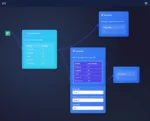
by tyler garrett | May 26, 2025 | Data Management
Organizations that want to thrive in a competitive landscape fuel their strategies with data. Yet, ambitious visions built on data-driven insights turn precarious when the very foundation—the data itself—is questionable. Today’s businesses require more robust, proactive controls to validate and sustain data quality, preventing inaccuracies from cascading down analytical and operational pipelines. Workflow-integrated data quality validation gates can serve as the strategic checkpoints that give decision-makers confidence in their data-driven initiatives. By embedding validation directly into business workflows and technical processes, organizations ensure that quality is enforced systematically and automatically throughout their entire analytics lifecycle. Let’s delve into how these validation gates can transform your processes into trusted, value-generating mechanisms.
Understanding Workflow-Integrated Data Quality Validation Gates
Workflow-integrated validation gates combine principles of data governance and data engineering to establish checkpoints embedded within data processing pipelines and workflows. Rather than treating data quality as a separate task, validation-driven gates ensure quality checks occur at natural intersections in your sequences—such as ingestion points, transformation stages, or right before delivery and visualization. When validation gates fail, they trigger predefined actions like alerts, quarantines, or rollbacks—preventing poor-quality data from infecting downstream analytics and impacting strategic decisions.
Integrating validation gates into everyday workflows encourages organizations to adopt a proactive data quality management culture. Validation gates work smoothly alongside dimension conformity enforcement in data integration, amplifying consistency and interpretability across your analytics environment. Decision-makers aiming at relevant insights need assurance of robust, quality-checked datasets available at all times—and embedding these checks naturally within workflows guarantees the data is appropriately vetted at every meaningful step.
For instance, if a fintech firm seeks compliance-related insights, embedding validations deeply could leverage findings from Dev3lop’s exploration on the importance of data privacy in fintech. Similarly, sophisticated validations ensure compliance requirements are upheld and constant.
The Strategic Value of Integrated Quality Validation Gates
In the era of rapid digitization, high-quality data serves as fuel for analytical engines, strategic decisions, smart automation, and AI-driven forecasts. However, without integrated validation mechanisms, you risk wasting resources analyzing misleading insights or doubling back to rectify avoidable errors highlighted too late. Workflow-integrated validation gates provide a systematic, methodical approach to maintaining data quality standards consistently. When appropriately embedded in workflows, data validation becomes automatic and preventative—not only identifying errors but actively preventing them from propagating.
This strategic integration ensures leadership’s confidence in data, facilitating trustworthy and impactful decisions derived from analytic results. In sectors where rapid decision-making relies on real-time analytics, like finance, healthcare, or logistics, this trust becomes essential—a single instance of poor-quality data can cascade exponentially, harming reputations and causing financial loss. Incorporating thoughtful data validation regularly into workflows offers defense against such scenarios, strengthening your overall governance and compliance posture.
Strategically employing validation gates advances organizations to move from reactive problem-solving toward proactive assurance, enabling more agile execution of innovation goals. Leveraging services such as Dev3lop’s specialized data visualization consulting helps businesses visualize data quality, empowering leaders and stakeholders to clearly monitor validation-triggered events and analytical outcomes, promoting definitive, agile responses.
Implementing Validation Gates in Your Data Workflows
To harness the power of integrated validation gates effectively, organizations must engineer thoughtful placements within their data pipelines. This integration goes beyond simple quality checks performed only at ingestion. Instead, intelligent data validation checkpoints need strategic positioning at critical intersections throughout data preprocessing, ETL workflows, transformations, and especially prior to analytical outputs or end-user reporting.
Start implementation by identifying essential pipeline stages—data ingestion, transformation phases, model inputs, and just before analytical consumption. Next, document the exact data quality criteria crucial to each step, such as value accuracy, conformity, freshness, completeness, uniqueness, legitimacy, and referential integrity. Clear communication with stakeholders ensures everyone understands quality validation gates as integral, non-negotiable parts of the analytical structure.
Leveraging well-established standards and enforcing validation methods, organizations can embed specialized validation logic, such as custom language-aware processing approaches similar to Dev3lop’s article on custom collators for language-aware data processing—a compelling reminder that specialized needs require specialized methods. Similarly, implementing validation gates through type-safe code methodologies, as explained in Dev3lop’s examination of type-safe data pipeline development, reinforces confidence that structural mistakes and mismatches are detected early, drastically reducing late-stage errors or costly breakdowns.
Automating Data Quality Through Smart Validation Rules
Effective workflow-integrated validation gates thrive with automation. Rather than relying on periodic manual checks, smart automation utilizing rule-based validations and machine-learning-powered anomaly detection ensures continuous, real-time monitoring and remediation. Automated processes instantly track deviations from expected behavior patterns, flagging anomalies proactively, often before human eyes notice any issues.
Automation leads to increased efficiency, reduced human error, and enhanced scalability—organizations can validate increasingly hefty and complex data ecosystems without scaling proportional manual efforts. Combining machine learning algorithms with intuitive visual analytics maximizes these results, delivering dashboards that highlight validation triggers and pinpoint root causes in clear visual terms.
Decision-makers benefit immensely from utilizing automated validations alongside principles like those detailed in Dev3lop’s analysis of visual encoding channels effectiveness and their detailed recommendations on data visualization principles. The synergy between automated validation gates and advanced visualization simplifies data quality insights, equipping stakeholders and analysts with straightforward pathways to understand anomalies and validate accuracy confidently and rapidly.
Continuous Improvement and Data Quality Transparency
The role of validation gates goes beyond catching errors; they form the backbone of enhancing continuous improvement and transparency throughout an organization. With accurate recording of validation outputs and subsequent analytical insights, companies can audit their workflows, identify recurring errors, and implement structural or process modifications accordingly.
Continual transparency facilitated by validation gates ensures stakeholders maintain confidence in analytical results. Rigorous documentation and reporting of validation gate failures and their resolutions help stakeholders trust the organization’s commitment to upholding data rigor. Advanced data visualization can serve effectively in these scenarios, as reputable visual representations keep stakeholders informed of ongoing optimization efforts, wins, and areas for improvement.
Additionally, transparent validation records reinforce compliance positions. Precise, documented validation checks protect organizations during audits, litigation, or regulatory scrutiny—whether managing sensitive privacy-regulated environments like fintech or highly regulated industries with intense compliance requirements. Strategic validation gates and their automated documentation records become vital assets, demonstrating a comprehensive diligence toward managing data quality, privacy, and regulatory adherence.
Why Workflow-Integrated Validation Gates Are Essential for Innovative Organizations
The modern marketplace demands speed, integrity, and accurate decision-making. Workflow-integrated data quality validation gates support these demands, ensuring your team accesses trustworthy analytical results at each workflow intersection. With proactive embedding, automated gate rules, visual analytics, and customized implementations, organizations can transition confidently toward sustained data maturity.
In practice, thoughtful implementation of integrated data validation gates protects your entire data management ecosystem—maximizing value generation, minimizing errors, and upholding data governance. The results are amplified efficiency, reduced downtime, and the agility needed to innovate and pivot quickly to market demands. Utilizing strategic and specialized consulting solutions, such as those offered by Dev3lop, strengthens your analytics infrastructures and prepares your competitive advantage for a sustainable, data-driven future.
Data excellence is no longer optional—it is foundational. With workflow-integrated validation gates securely established in your analytics ecosystem, your organization can confidently navigate complexities, pivot swiftly, and deliver innovative, strategic decisions grounded firmly on quality-assured data.
Thank you for your support, follow DEV3LOPCOM, LLC on LinkedIn and YouTube.

by tyler garrett | May 26, 2025 | Data Management
Imagine your team diligently building innovative solutions, utilizing powerful analytics and cutting-edge data insights to drive critical business decisions. But alongside innovation, one foundational element must never be compromised: data security. Especially when replicating production databases into non-production environments, such as testing, development, or sandbox settings, teams may inadvertently expose sensitive customer or organizational data. Metadata-driven data obfuscation emerges as a leading strategy to balance the scales between innovation, compliance, and security. Let’s delve into this transformative approach, explore methodologies, and discuss how proactively integrating metadata-driven obfuscation techniques can empower your software development pipeline—fostering smarter decisions, a safer governance model, and paving a secure pathway toward analytics excellence.
Understanding the Importance of Non-Production Data Obfuscation
Non-production environments often mirror the production databases to ensure developers can accurately test and implement functionalities. However, failing to obfuscate sensitive data during these transfers poses substantial security risks. Breaches occurring due to non-production datasets can expose Personally Identifiable Information (PII), Protected Health Information (PHI), or financial information resulting in reputational harm, regulatory fines, and loss of client trust.
To mitigate these risks effectively, metadata-driven data obfuscation offers a robust approach. Unlike traditional data scrambling, this method leverages data characteristics or data contract-driven development processes—defining metadata attributes that clearly identify sensitive columns across databases. By systematically categorizing and flagging data elements via metadata, further automation and accuracy become achievable, providing efficient, secure data masking.
Implementing metadata-driven obfuscation ensures that teams have clear governance protocols, explicit guidelines, and well-defined responsibilities to consistently protect sensitive data. It elevates your company’s information confidentiality and regulatory alignment, driving innovation without compromising compliance.
A Deeper Look into Metadata-Driven Obfuscation Methodologies
So what exactly comprises metadata-driven obfuscation methodologies? At its core, this approach uses metadata—information describing your data—to identify precisely what requires protection. Inspecting metadata enriches data catalogs or repositories to tag fields that necessitate masking such as social security numbers, emails, and financial data. This structured approach simplifies maintenance and dramatically improves scalability across large datasets and multiple development environments.
Effective metadata-driven obfuscation typically follows these sequential phases:
Metadata Discovery and Tagging
The starting point involves automated or manual processes that scan database schemas, alter table structures, and dig into comprehensive system documentation. During this discovery process, sensitive columns and tables are marked explicitly with actionable metadata labels. By marking metadata once, data teams create a reusable, standardized mapping mechanism, significantly reducing redundant activities and minimizing manual errors.
Defining Masking Rules Driven by Metadata
Once the sensitive columns are clearly labeled, masking rules are established based explicitly on this metadata. Such rules stipulate how data masking should be carried out—whether through scrambling algorithms, numeric replacements, or synthetic data generation methods. Coupling clear definitions and standardized metadata enables data teams to rapidly automate and apply safeguards consistently and correctly across entire datasets.
Automated Masking Execution
Finally, automated metadata-driven algorithms execute obfuscation based on predefined rules. Utilizing metadata to inform data pipelines or specialized obfuscation tools ensures your non-production environments dynamically maintain privacy standards, allowing for quick and compliant replication procedures.
How Metadata-Driven Obfuscation Enhances Innovation
Metadata-driven obfuscation doesn’t hinder innovation but substantially facilitates it. For teams at the forefront of analytics-driven decisions—where speed, agility, and feedback matter—this method aligns with modern agile data environments. By incorporating these methodologies, developers and testers benefit from realistic test datasets, without exposure to sensitive, production-level data.
Consider a scenario involving machine learning for fraud detection. Accurate experimentation and training require realistic scenarios and data patterns. Metadata-driven obfuscation provides representative datasets retaining statistical relationships and trends necessary for effective analysis without compromising privacy. By maintaining data realism, teams maximize effectiveness, translating seamlessly into powerful analytical insights and successful models, without security repercussions.
Furthermore, metadata-driven obfuscation pairs effectively with innovative practices like implementing animated transitions in dashboards, or expedient data ingestion pipelines such as dynamically transferring data from platforms like Instagram to BigQuery with Node.js. Secure data preparation enriches user experience design, dashboard insights, and granular analytics, empowering developers and data scientists to advance rapidly at the intersection of secure and intelligent analytics.
The Role of Automation and AI in Metadata-Driven Obfuscation
Automation is foundational to effective metadata-driven obfuscation. Leveraging AI-powered algorithms and smart automation strategies dramatically enhances speed, accuracy, and scale. AI-driven data cataloging solutions intelligently identify sensitive data attributes, mitigating human oversight or inconsistency inherent to manual processes. These solutions use machine learning-driven techniques similar to those explored in our article on pattern spotting in fraud detection.
Beyond improving accuracy in sensitive data classification, leading teams increasingly adopt automation in the obfuscation execution stages using high-performance code generation for data transformations. These AI-powered code-generation strategies further streamline and accelerate obfuscation processes, offering near real-time data protection and integration into continuous integration/continuous delivery (CI/CD) pipelines. Adopting AI-driven enhancements within metadata-driven methodologies fortifies your entire software lifecycle and accelerates development cadence significantly.
If considering nascent AI automation opportunities to fit within your strategic data plans, leveraging our advanced AI agent consulting services can transform your metadata-driven obfuscation approach. Guided by experienced expertise, your teams can scale securely, automate efficiently, and innovate confidently.
Challenges and Recommendations for Implementing Metadata-Driven Obfuscation
Adopting metadata-driven obfuscation comes with strategic considerations and operational challenges. Initially, accurate metadata identification and classification can pose complexity, particularly within organizations not familiar with meticulous data cataloging. Additionally, ongoing maintenance and agility within rapidly-evolving data environments require cross-team alignment and robust data contract-driven development practices.
To address these implementation challenges effectively:
- Ensure organizational commitment to standardized data governance processes, leveraging industry best practices and frameworks.
- Design clearly documented data security guidelines and enforce accountability around metadata stewardship roles.
- Cross-collaborate among business, technical, and compliance stakeholders, aligning metadata-driven strategies with operational requirements and priorities.
- Regularly review and refine metadata frameworks, adapting dynamically to changing data characteristics and evolving privacy regulations.
Addressing these potential challenges head-on positions your organization uniquely at the intersection of secure practices and innovative advantage within modern software environments.
Conclusion: Higher Standards, Enhanced Innovation, Smarter Analytics
In an era characterized by continually heightened privacy scrutiny, regulatory compliance, and data-driven innovation, metadata-driven data obfuscation emerges as a critical strategy for safeguarding sensitive information within non-production environment datasets. It leads your organization towards greater assurance in data protection and compliance practices, improved efficiency through automation, and increased speed to analytics-driven value.
Whether you’re manually curating complex data warehouse structures, utilizing SQL commands like GROUP BY aggregation, exploring JavaScript for front-end analytics (check these JavaScript insights), or integrating AI-driven code generation, metadata-driven obfuscation will consistently raise your organizational analytics standard safely and sustainably. By proactively integrating metadata-driven data obfuscation methods, companies confidently maintain data security while capitalizing on analytics’ transformative power.
Take the next strategic step by aligning your data practices with metadata-driven methodologies—unlocking innovation potential while safeguarding your strongest strategic asset: data.
Thank you for your support, follow DEV3LOPCOM, LLC on LinkedIn and YouTube.

by tyler garrett | May 26, 2025 | Data Management
Modern enterprises constantly wrestle with massive data flows pouring in from multiple touchpoints, applications, and business units. Managing these disparate streams can become overwhelmingly complex without robust validation, governance, and adherence to standard formats. Enter Schema Registry—a centralized checkpoint designed to verify and enforce precise data schemas across integrated systems. With organizations increasingly relying on near-instantaneous analytics and real-time decision making, schema registries transcend traditional oversight; they become linchpins ensuring data consistency, quality, and accelerated innovation. This blog post demystifies the strategic role of schema registry enforcement in data integration flows, spotlighting its critical significance for maintaining accurate, actionable data within dynamic, data-rich business landscapes.
Understanding Schema Registries in Data Integration
A schema registry is essentially a centralized hub that holds and manages data schema definitions across multiple producers and consumers within your organization’s data pipelines. It acts as a governed library of structured data formats, where every schema, whether JSON, Avro, or Protocol Buffers (protobuf), is registered, versioned, and validated continuously. By enforcing a consistent structure, a schema registry prevents incompatible or invalid data from compromising downstream data pipelines, analytics processes, and applications.
In a world driven by rapid analytical cycles—such as the real-time data requirements detailed in our recent analysis of watermark management in event-time data processing—accuracy and reliability at every step has a meaningful impact on analytics outcomes. Schema registries elevate the conversation around data governance, turning otherwise fragmented ecosystems into cohesive data repositories. They enable teams to collectively enforce consistent data structures, reducing friction and integral to a well-orchestrated data engineering strategy.
Adopting stringent schema validation processes also ensures the confidence and trustworthiness of data analytics and business intelligence outcomes. Schema registries serve as a guardrail, guiding teams toward data consistency while simultaneously accelerating innovation—allowing analysts and developers to iteratively improve their processes without breaking integrations downstream.
The Value of Schema Enforcement in Enterprise Environments
Schema enforcement streamlines interoperability among diverse systems, fostering stable integration paths. Enterprise architectures often consist of an intricate network of applications, databases, and third-party tools sharing critical information—but mismatched schemas between upstream data sources and downstream analytics engines routinely jeopardize data validity. Schema enforcement tackles this issue head-on by setting unequivocal guidelines and validation protocols that underpin a coherent data taxonomy across the ecosystem.
An overlooked benefit of schema enforcement is improved data quality—which critically impacts profitability. In our blog Data Quality: The Overlooked Factor in Profitability, we highlighted how precise definitions and consistent data formats lay foundations for accurate analyses, reliable predictions, and financial success. Clearly defined schemas empower your analytics and operational frameworks, delivering immediate return on investment by reducing costly remediation efforts, mitigating integration risks, and increasing efficiency, not just in IT but also in business decision-making.
Moreover, as businesses increasingly adopt agile methodologies, schema registries make it practical to rapidly iterate on data integrations without ceding stability. With confidence in data definitions, your data teams can comfortably focus on declarative data transformation, significantly reducing development overhead and maintenance complexities by trusting the registry-enforced schema as a standard.
Challenges Solved by Schema Registries in Integrations
Integrations without schema registries often face consistent and costly issues: unexpected data changes, version control nightmares, and the domino effect of downstream system failures. Without concrete schema enforcement, teams rely on manual intervention, increasing error rates and introducing invisible risks within their critical data flows.
For example, consider language-sensitive data pipelines outlined in our blog on custom collators for language-aware data processing. Without precise schema enforcement, unexpected encoding structures or language-specific data nuances can quickly lead to analytics inaccuracies or even total service disruptions. Schema registry ensures that the encoding, formatting, and language-aware constraints are meticulously adhered to, enabling robust multilingual integrations.
Managing schemas manually across heterogeneous teams increases communication overhead, impedes transparency, and inhibits productivity. Schema registries tackle this coordination challenge directly by implementing version control, precise documentation, and shared schema visibility. Schemas become the single authoritative truth, freeing teams from manual schema reconciliation and shifting focus toward innovation and achieving business objectives.
Implementing Schema Registry: Best Practices and Considerations
Embarking upon effective schema registry implementation requires strategic foresight and rigorous adherence to established best practices. Begin by clearly defining standard conventions within your domain and ensuring all data participants share a conceptual awareness. As explained in our post on domain-driven data design and bounded contexts, aligning schema registry enforcement with clearly understood domain boundaries significantly streamlines schema governance.
Choosing modern, open-source solutions such as Confluent Schema Registry or Apicurio can bring significant improvements. Whether your architecture leans closer to Kafka, Pulsar, or event-driven frameworks, schema registries integrate effortlessly into existing messaging systems and platform tooling. Streamlining deployment infrastructures by leveraging schema validation in continuous integration/continuous delivery (CI/CD) pipelines also helps maintain rapid iteration without sacrificing data integrity.
Moreover, invest early in team training and establish clear processes for schema evolution, including backward and forward compatibility considerations. Encourage developers and analysts alike to develop familiarity with registry tooling, continuous validation practices, and schema version upgrades, thus preventing costly rework and downtime later downstream.
Tools and Technologies: Making Schema Enforcement Simple and Scalable
A variety of schema registry tools exist to streamline processes and maximize schema governance effectiveness. Apache Avro and Protocol Buffers, for example, have schema enforcement capabilities highly favored for compatibility management, serialization efficiency, and robust validation features. Modern cloud-native platforms also embed schema validation options directly or offer managed service alternatives, accelerating integration with minimal infrastructure overhead.
Information management solution architects often find Java-based tooling advantageous—our article comparing Mac vs Windows for JavaScript development in VS Code underscores platform considerations necessary to maintain efficient schema management practices. Lightweight integration can also be achieved using REST APIs or integrations provided by Kafka eco-systems, facilitating rapid adoption among development teams.
No discussion of schema enforcement tools would be complete without acknowledging that efficient analytics rollouts often hinge on user-specific customization, as illustrated in our recent discussion of visualization personalization driven by user analytics knowledge. Well-governed, schema-compliant data ensures underlying data quality, feeding directly into more intelligent, personalized visualization capabilities for stakeholders across the organization.
Continuous Improvement and Innovation Through Schemas
The discipline inherent in schema registry management fosters a culture of continuous improvement throughout data-driven organizations. Teams that practice stringent schema validation quickly catch potential data problems before they magnify, enabling proactive, preventative remediation strategies rather than reactive firefighting. This stability becomes instrumental in operational predictability, drastically lowering the lifetime maintenance of your data environments.
Schema enforcement frees analytics teams from manually verifying data integrity, allowing greater resources to reallocate toward innovative analytical efforts. Activity previously confined to manual validation, troubleshooting, and firefighting transforms into proactive data enhancements that deliver measurable business impact, similar to benefits discussed in our analysis on data analytics enhancing public safety initiatives in Austin.
Organizations committed to being proactively agile recognize schema registries as foundational to ongoing innovation in ensuring scalability, reliability, and governance within their growing analytics infrastructures. Metadata standards, schema validation rules, and data governance intersect hierarchically in a schema registry, creating measurable operational advantages required to thrive in today’s data-rich business environments.
Conclusion
The strategic use of schema registries for enforcing data integrations elevates data accuracy, trustworthiness, and consistency—factors critical for thriving in a complex business landscape dependent on analytical insights. Organizations successfully leveraging schema registries move confidently forward, free from incompatible data formats or integration nightmares, and equipped to undertake rapid, continuous innovation. Schema registries aren’t simply infrastructure—they are foundational pillars supporting agile, data-informed decision-making.
Thank you for your support, follow DEV3LOPCOM, LLC on LinkedIn and YouTube.

by tyler garrett | May 26, 2025 | Data Management
The rules of business competition have transformed. Today’s valuable commodities are data-driven insights and efficiency, not only physical products or services. Leading businesses now recognize the need to treat data itself as a strategic product, managed by robust product development workflows and frameworks similar to traditional product management. Implementing a solid Data Product Management Framework isn’t a mere technical task—it’s a strategic imperative that empowers your organization to exploit its data’s full potential, driving innovative decision-making and sustainable growth. To begin this journey, let’s dive into how you can successfully implement a structured, measurable, and agile Data Product Management Framework and capitalize on your organization’s critical information assets.
Why Embrace a Data Product Management Framework?
A comprehensive Data Product Management Framework represents a roadmap for systematically developing, monitoring, and iterating data products within your organization. In the modern business landscape, data isn’t just gathered and stored; it’s actively leveraged as strategic assets—insights, algorithms, compelling visuals, or predictive analytics—guiding business decisions, customer interactions, and competitive strategies. Without treating data as a product, valuable insights risk becoming lost, obscured, or untapped. Instead, applying a structured data product management approach brings clarity to internal teams, boosts data quality, and enhances analytic capabilities at scale.
Effectively managing data products means clearly defining roles, expectations, data governance standards, and creating clean, well-documented, and reusable analytics pipelines. Organizations that adopt data product thinking ensure more efficient use of their engineering resources by avoiding unnecessary rework and depreciation of analytical assets. By structuring your company’s data portfolios using product management principles, you mitigate inefficiencies and scalability issues that traditional analytics projects frequently encounter. Moreover, aligning your analytics projects with structured methodologies can greatly reduce miscommunications and ensure team collaboration. For example, incorporating systematically designed working sessions can improve interactions between engineers, analysts, and product stakeholders, streamlining workflows, and facilitating clearer business-value alignment.
Foundational Pillars of a Data Product Management Framework
Clear Product Definition & Ownership
A primary tenet of a Data Product Management Framework is having a clearly defined data product vision guided by assigned product management roles. A dedicated Data Product Manager is essential to maintain clarity around strategic goals, ownership, and accountability. By clearly defining data products—such as dashboards, analytic pipelines, visualizations, predictive models, or even entire data ecosystems—responsibilities become unequivocally communicated, and governance standards set clear data usage objectives.
Assigning dedicated product owners ensures continuous monitoring, upkeep, usability enhancements, and smooth iteration on your analytics assets. This also helps reduce any ambiguity regarding responsibilities, minimizes duplication in tasks, and modifies data products quickly according to shifting business strategies or market conditions. Furthermore, distinctly defined roles give stakeholders clarity about whom to contact for any modifications, ensuring timely responses and resolutions. A product-driven approach draws heavily from traditional product management practices, promoting the efficient usage of analytic toolsets such as Power BI or custom analytic pipelines developed for specialized data applications.
Efficient Data Engineering and Management
Data itself, of course, is at the core of any data product management framework. Using proven data management practices, your company can harness modern data sources, perform ETL operations efficiently, and maintain stable data operations. Establish meticulous data ingestion and integration protocols, streamlining how new data rows enter your databases by incorporating standardized methods like the SQL command INSERT INTO. As databases grow more complex, establishing specific methodologies of smoothly integrating new records becomes crucial.
Efficient data engineering ensures robust data delivery regarding quality, consistency, accuracy, and availability. Organizations should also embrace tools optimized for their particular scenarios and workloads. An informed strategic decision about database technology—such as understanding the specifics of PostgreSQL and SQL Server differences—can have a significant impact on the success of data products. Smooth operations also require engineers to diagnose and fix issues promptly, such as quickly managing frequent but necessary tasks like resetting MySQL root passwords.
Visualization and User Experience Optimization
A well-designed Data Product Management Framework highlights analytics visualizations and intuitive user experiences. Good visualization designs are central to helping stakeholders grasp complex data, clearly communicate insights, and make informed decisions quickly. Apply thoughtful visualization methodologies, such as waffle charts or modern isotype charts, to simplify complex analytics in a user-friendly manner, enhancing stakeholder trust in data-driven decision-making.
Furthermore, analytics tools should be easily navigable, intuitive, and designed with the end-user in mind. Product managers and analytics engineers can collaborate with UX/UI experts to ensure analytics dashboards and interfaces maintain coherence, consistency, and proper navigational hierarchy. Improving visualization quality directly translates to higher adoption rates, better internal communication, and ultimately significant business results. Analytics becomes actionable, relatable, and impactful when visual design strategies align seamlessly with your current and evolving business requirements.
Scalability Through Automation and Intelligent Architecture
The Data Product Management Framework inherently entails scalable practices for effective long-term product utilization. Scalability isn’t only about infrastructure; it involves the efficient orchestration of operations, agile methodologies, and intelligent software design practices that effectively accommodate growth. Organizations must establish an intelligent and flexible architecture that enables scalability of workflows and effectively addresses infrastructure demands proactively.
Embrace tools and methodologies that support distributed computing and scalable data operations. For instance, implementing innovative methods such as the Distributed Snapshot Algorithm can better manage growing data pipelines, ensuring consistency, performance, and reliable operations. Additionally, utilizing data optimization methods such as a query mesh optimization approach ensures optimal data query performance and smooth pipeline operations even as complexity grows. Scalable practices ensure your data products remain performant, reliable, and resource-efficient even as the business expands or reporting demands increase.
Continuous Improvement and Governance
A sustainable Data Product Management Framework rests upon continuous improvement mechanisms and strong governance to ensure the quality remains high, the value stays relevant, and the security unquestionable. Continuous monitoring, efficient documentation, regular stakeholder feedback sessions, and a structured iteration process ensure governance excellence. Setting clear standards, implementing precise governance policies around data security, availability, and integrity ensures compliance with legal obligations and reduces risk.
A solid governance strategy ensures both accuracy and trust, establishing guidelines around data availability, lifecycle management, and quality assurance standards. Product-centric data governance emphasizes collaboration across participants. Consider incorporating regular reviews, documentation quality checks, agile SCRUM methodologies, or Kanban boards into your governance framework, empowering cross-functional teams to contribute effectively to data product evolution. By treating your data products similarly to traditional products—iteratively improving upon their lifecycle—you unlock lasting value and powerful internal and external competitive benefits.
Implementing the Framework—Putting Theory to Practice
The successful implementation of a Data Product Management Framework involves a careful change management strategy, team buy-in, solid leadership support, and an agile, strategic mindset. Executive sponsorship is essential for demonstrating leadership support, driving organization-wide adoption, and ensuring clarity across departments. Communicate clearly with stakeholders about the framework’s strategic benefits, provide thorough education and training across project milestones, and iterate through actionable small-scale implementations to showcase incremental successes.
Empower your team through regular training sessions, collaborative workshops, and targeted knowledge sessions that cover framework methodologies, tool adoption, and industry best practices. A phased approach towards adoption mitigates risk and facilitates iterative improvements. Remember, the heart of successful analytics frameworks lies in clarity, practicality, flexibility, scalability, and most importantly—resource and strategic alignment.
Data represents your organization’s next significant strategic opportunity; a structured Data Product Management Framework allows your business to unlock its hidden potential effectively. Implement these strategic guidelines, proactively communicate with stakeholders, and adopt agile principles to ensure analytics and insights remain valuable, sustainable assets fueling your organization’s success.
Thank you for your support, follow DEV3LOPCOM, LLC on LinkedIn and YouTube.

by tyler garrett | May 26, 2025 | Data Management
In an era where data fuels innovation, companies stand or fall by how effectively they manage their data assets. While most enterprises acknowledge the importance of securing primary datasets, fewer pay enough attention to derived data—the enriched, transformed, and processed versions that often power advanced analytics, customer insights, and strategic decisions. Proper rights management for these derived data assets ensures regulatory compliance, promotes collaboration, and mitigates risks of misuse or unintended exposure. By laying down the foundation of smart practices and robust frameworks for managing derived data’s intellectual property and access rights, organizations can unlock greater agility, foster innovation, and confidently harness their data landscape’s full potential.
Understanding Derived Data: The New Frontier of Data Rights Management
Data teams worldwide generate immense amounts of derived data each day, including enhanced analytics outputs, complex predictive models, and sophisticated visualizations. Made from base datasets, derived data assets often represent proprietary insights and competitive advantages crucial to organizational innovation and growth. However, companies frequently overlook these datasets when discussing data governance and security. Derived data is particularly susceptible to rights mismanagement due to its indirect origin and ambiguous lineage. By not explicitly defining ownership, usage rights, and access controls, organizations could unknowingly expose themselves to regulatory scrutiny and unanticipated liabilities.
Consider credit scoring models in financial institutions, built from customer transaction databases. While securing customer transaction data is standard practice, how many companies diligently articulate proprietary usage rules around the derived credit scoring algorithms? Similarly, geospatial visualizations like the ones produced using advanced cartogram implementations often include layers of public and private data. If ownership stakes and usage permissions aren’t clearly delineated, these visualizations risk unauthorized redistribution, intellectual property disputes, or competitive harm. In short, derived data demands the same rigorous rights management practices as foundational datasets—if not more.
The Risks of Ignoring Derived Data Rights Management
The rapid proliferation of data analytics practices, from traditional business intelligence reports to innovative AI models, has caused derived data assets to multiply exponentially. Without clear systems in place to handle rights around these data derivatives, organizations face mounting risks. The most immediate threat is compliance. Regulatory standards, such as GDPR or CCPA, mandate precise tracking of customer data usage and derived analytics. Neglecting derived data rights management leaves companies vulnerable to infringements, fines, and reputational damage.
Another risk factor involves intellectual property—valuable analytic structures or proprietary visualizations can be lost, mishandled, or misappropriated without proper oversight. Take advanced distributional analyses represented through visual analytics techniques like violin plot implementations. Without clearly assigned rights, these analytical insights could leak into public domains or competitive organizations, diluting competitive differentiation and wasting research and development investments. Weak controls and ambiguous ownership models hamper collaborations too, making it difficult to share data across teams, geographies, and partner ecosystems safely and smoothly.
Finally, without explicit governance policies, derived data creates opportunities for misuse, either through intentional exploitation or unintended mishandling. Organizations must prioritize rights management controls for all data, ensuring stakeholders clearly understand their roles, responsibilities, and restrictions around data derivatives.
Implementing Robust Derived Data Rights Management Practices
No organization gets rights management right overnight; it’s a structured, continuous process requiring coordination, planning, and governance oversight. First and foremost, organizations should establish clear data governance structures that explicitly recognize derived data rights management. Data governance councils should ensure alignment among business, legal, and technical stakeholders, providing vision, guidance, and accountability as rights policies evolve across the enterprise.
Developing detailed data lineage maps can also mitigate derived data risks. Data lineage tracking can effectively document the transformation processes data undergoes from initial ingest to analytical consumption. Companies leading in modern data architectures utilize sophisticated cloud-based data frameworks—such as the ones described in discussions around data lakehouse implementations—to intelligently capture transformation metadata. Robust metadata registries and catalogs help organizations determine derived data ownership, simplify auditing, access management, and remediate issues proactively.
Implementing technology frameworks with effective rights management features is essential. For structured asset protection, leveraging role-based access controls (RBAC) specifically adjusted for analytic environments ensures the correct stakeholders with proper authorization access derived data assets. Technologies like Microsoft SQL Server significantly streamline managing, securing, and governing complex data environments, making partnering with Microsoft SQL Server consulting experts invaluable for optimizing data rights implementation.
Leveraging Automation and Parameterized Pipelines for Enhanced Control
Automation plays a pivotal role in securing derived data in dynamic, fast-paced enterprise environments. Automated tagging and metadata management ensure derived data rights and usage information consistently flow alongside analytic outcomes, reducing manual interventions and minimizing errors or omissions. Smart processes leveraging parameter-driven pipeline automation—such as those described in informative content about parameterized pipeline templates—allow standardized and scalable data processing procedures to embed information on rights management automatically.
Parameterized pipelines provide extensive flexibility, making it easier for data engineers and analysts to generate deterministic, secured data products aligned with established regulatory standards. With automated predefined governance rules embedded in these processes, organizations significantly limit regulatory breaches or unauthorized data usage, thereby ensuring compliance.
Automation further empowers report creators, dashboard developers, and analysts to innovate safely. For example, insightful customer-focused analytics like the customer lifetime value (CLV) analyses can offer tremendous market insights. Yet, without automated rights management tagging embedded in the analytic pipeline, these insights can unintentionally expose sensitive customer data beyond intended teams. Robust automated controls combined with intelligent pipeline templates ensure derived data asset governance comprehensively, consistently applied, and securely maintained throughout the analytic lifecycle.
The Competitive Advantage of Strong Derived Data Rights Management
While strong data protection and governance are frequently seen strictly through the lenses of risk mitigation, derived data rights management also carries tremendous strategic value. Enterprises excelling in managing derived data rights not only improve compliance posture but position themselves to confidently innovate faster without exposure concerns.
Industries competing heavily on sophisticated analytics, from healthcare to finance to e-commerce, find distinct market differentiation in securing and leveraging proprietary insights from their derived data products. Whether employing advanced fraud detection analytics or using creative visualization platforms to deliver actionable insights—like those discussed comprehensively in the article exploring the Tableau definition—rights-controlled data management enhances operational agility and accelerates innovation cycles.
Organizations achieve improved collaboration between internal stakeholders and external partners when transparency and clarity exist around derived data assets. Furthermore, clearly defined rights management protocols greatly reduce friction in cross-team communications, facilitating rapid deployment of new analytics capabilities. Ultimately, effective rights management strategies position companies to respond quickly and safely to rapidly evolving analytics demands, turning their data ecosystems into powerful engines of innovative growth.
Conclusion: Prioritize Derived Data Rights Management Today
Implementing comprehensive rights management for derived data assets isn’t simply good governance—it’s a competitive advantage and strategic imperative. Understanding the unique challenges and risks derived data presents should motivate every decision-maker to proactively embed rights management principles within their data analytics frameworks. By investing diligently in processes, aligning stakeholder responsibilities, and embracing automation technologies like parameterized pipeline templates, you can harness your organization’s data-driven potential fully and securely.
Remember, clear, actionable, and automated derived data rights management fuels innovation, compliance, and sustained competitive differentiation. To navigate this strategic data governance domain confidently, ensure your analytics infrastructure seamlessly integrates robust derived data management practices.
Thank you for your support, follow DEV3LOPCOM, LLC on LinkedIn and YouTube.

by tyler garrett | May 26, 2025 | Data Management
In today’s highly interconnected digital landscape, organizations across industries increasingly rely on sharing sensitive data to achieve mutual objectives. Whether supporting collaborative research in healthcare, ensuring seamless operations in complex supply chains, or fostering innovation through digital ecosystems, secure and trusted data sharing is more critical than ever. Implementing a robust Data Trust model empowers your organization to systematically exchange protected information while simultaneously guarding privacy, compliance, and trustworthiness. Armed with strong governance, clear accountability, and advanced data management practices, implementing strategic Data Trust solutions positions your organization to unlock deeper insights and foster innovation without sacrificing security. Let’s examine best practices, actionable insights, and strategic frameworks your team can leverage to achieve reliable and protected information sharing with confidence and efficiency.
What is a Data Trust and Why is it Crucial?
A Data Trust represents a trusted governance structure in which distinct legal entities agree upon and follow clearly defined rules for handling, exchanging, and processing sensitive data. Similar to a fiduciary trust used in finance, a Data Trust provides oversight by a neutral entity responsible for enforcing adherence to predetermined standards, rules, and expectations regarding data security, privacy, compliance, accountability, and access controls. Implementing this structure fosters stakeholder trust and mitigates risks inherent with sensitive or regulated information like healthcare, financial, or personally identifiable information (PII). Through a Data Trust, partners gain assurance about compliance with regulations such as GDPR, HIPAA, or CCPA from the foundational trust governance frameworks implemented upon inception.
The establishment of a clearly defined Data Trust also significantly reduces ambiguity, misunderstandings, or disputes about data usage and sharing agreements among stakeholders. By enforcing strong governance and data stewardship principles maintained universally across organizations within the ecosystem, your Data Trust can streamline and optimize data utilization for mutual benefit without neglecting individual responsibilities or regulatory obligations. Implementing robust governance procedures alongside well-documented effective data documentation strategies allows your organization to sustainably grow trust and leverage shared information resources, driving long-term collaborative benefits across your data partner landscape. Simply put, investing in Data Trust implementation establishes the bedrock of a successful information-sharing venture.
Key Considerations for Implementing a Data Trust Model
Clearly Defined Data Governance Frameworks
Essential to successful Data Trust implementation is establishing robust and transparent data governance mechanisms. A well-crafted framework explicitly defines data ownership rights, access privileges, responsibilities, compliance requirements, and key performance metrics. This clarity ensures every stakeholder understands their roles and the circumstances under which protected information is used and shared. Organizations that invest the time to build solid governance procedures experience fewer conflicts, easier regulatory audits, and smoother operational processes when handling sensitive data.
Consider actively involving technical and strategic stakeholders in defining your governance model to ensure alignment with organizational goals and external compliance standards. Developing clearly articulated data access policies using trusted database technologies, such as industry-standard MySQL, benefits from expert guidance through specialized MySQL consulting services. Implementing data governance frameworks guided by specialists results in robust databases and secure data processes tailor-made for your organization’s long-term data sharing strategies.
Flexible Data Infrastructure Design
Effective Data Trust implementation demands infrastructure that can reliably adapt to evolving data schemas, formats, and system requirements. As more parties join your data ecosystem and regulatory standards change, you need the agility to accommodate shifting standards and expectations. Developing infrastructure flexible enough to permit smooth collaboration helps future-proof your Data Trust, reducing costs associated with major platform rebuilds, data migration project risks, or disruptions to access controls.
Leveraging innovative design strategies such as establishing systemic guidelines for schema evolution patterns with backward compatibility provides critical adaptability. Additionally, learning how and when to implement various data platforms by navigating decisions regarding data lakes versus traditional data warehouses brings strategic advantage and stability to your infrastructure approach. Appropriate flexibility integrated into your Data Trust architecture guarantees preparedness for future technological developments, new data schemas, and changes in business strategy or regulatory requirements.
Advanced Privacy & Security Strategies
When handling sensitive, protected data, your Data Trust must incorporate multi-layered security protocols and privacy tools dedicated to safeguarding participant information. From strict access control policies and tokenization techniques to encryption standards and advanced anomaly detections, your security approach should be comprehensive and layered. Leveraging sophisticated detection methods, including proactive data skew detection and handling in distributed processing, ensures early resolution of potential privacy and security threats, safeguarding organizational and stakeholder trust in your Data Trust operations.
Equally critical are advanced, privacy-driven solutions ensuring consent management and regulatory compliance. Integrating tools to achieve an optimal balance in balancing data collection with user privacy proves invaluable in implementing a compliant Data Trust. By prioritizing rigorous security and privacy practices within your data sharing approach, you establish necessary credibility and trust among stakeholders, ensuring long-term project value and sustainability.
Integrating Analytics & Machine Learning Effectively
One significant advantage of a properly implemented Data Trust is the streamlined utilization of advanced analytics and machine learning solutions across collaborating stakeholders. Implementing structured, governed data repositories can unlock innovative machine learning use-cases previously inaccessible or too risky due to mistrust or privacy concerns. Formal data governance enables improved alignment of analytics outputs and actionable insight-sharing processes across the diverse community in the Data Trust.
To maximize this opportunity, incorporate best-practice principles for machine learning pipeline design for production environments. Effective pipeline design ensures models developed on shared protected data comply with governance expectations, meet regulatory requirements, and achieve trustworthy results that stakeholders can confidently leverage for transformational decisions. A strategic approach to integration of analytics demonstrates the tangible benefits of your Data Trust framework to partners, creating lasting business benefits for all participants.
Navigating Regulatory Challenges & Compliance Risks
Successfully implementing a Data Trust involves proactive navigation of regulatory complexity and compliance requirements surrounding sensitive and protected data. Understanding different regional and industry-specific obligations informs crucial policy-setting and ensures legal protection across partner organizations. Engaging experienced data governance specialists who deeply understand compliance implications throughout the Data Trust lifecycle can make all the difference in preventing costly regulatory breaches or non-compliance penalties.
Carefully document processes, purpose-driven policies, and robust technical architectures. Applying rigorous documentation best practices as highlighted in our guide to effective data documentation strategy allows your organization to effectively address regulatory audits and demonstrate transparent compliance oversight. Organizations that strategically navigate regulatory frameworks build stakeholder confidence in your Data Trust, promoting wider adoption and greater participation across industries.
Implementing Data Trust as a Strategic Advantage
When thoughtfully designed and successfully deployed, a Data Trust represents more than compliance or risk mitigation—it can provide a significant competitive edge, support innovation, and deepen strategic partnerships with ecosystem participants. Leveraging state-of-the-art technical solutions such as functional programming paradigms for resilient data transformation logic allows organizations to develop robust, maintainable data processes that withstand regulatory changes and rapid business evolution.
Ultimately, placing Data Trust implementation at the core of your protected information sharing strategy positions your organization ahead of competitors, provides a risk-managed environment for innovation, and establishes the foundation for trusted data ecosystems. With the right approach, strong governance, advanced security, and effective analytics integration, your Data Trust will become a driving force in achieving strategic business goals and sustained growth.
Thank you for your support, follow DEV3LOPCOM, LLC on LinkedIn and YouTube.






























